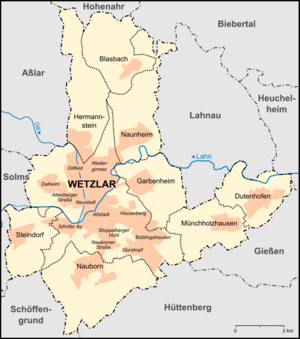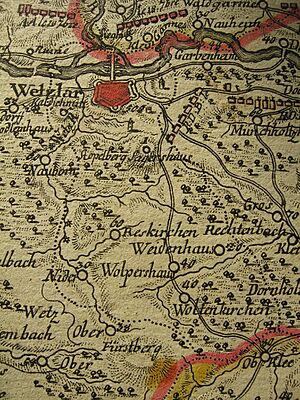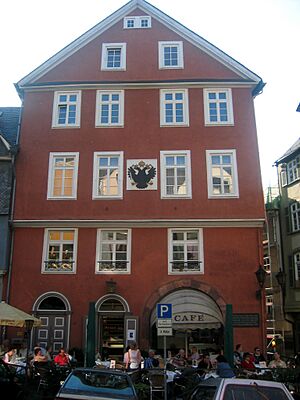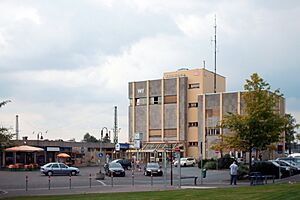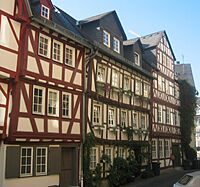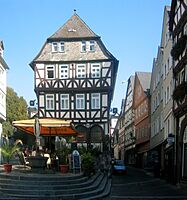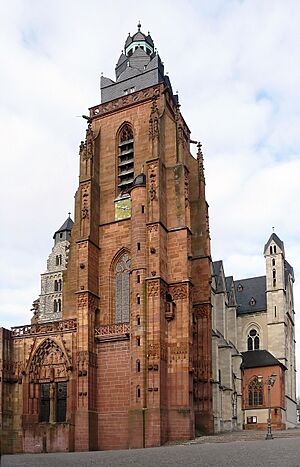Wetzlar facts for kids
Quick facts for kids
Wetzlar
|
|||
|---|---|---|---|

The old town and the old Lahnbridge
|
|||
|
|||
| Country | Germany | ||
| State | Hesse | ||
| District | Lahn-Dill-Kreis | ||
| Elevation | 148-402 m (−1,170.9 ft) | ||
| Population
(2022-12-31)
|
|||
| • Total | 54,187 | ||
| Time zone | CET/CEST (UTC+1/+2) | ||
| Postal codes |
35576–35586
|
||
| Dialling codes | 06441, 0641, 06446 | ||
| Vehicle registration | LDK, WZ | ||
| Website | wetzlar.de | ||
Wetzlar is a city in the state of Hesse, Germany. It's the twelfth largest city in Hesse. In early 2019, about 55,371 people lived there. Wetzlar is an important place for culture, industry, and business. It's also a university town and one of the top ten regional centers in Hesse.
This city was once a "free imperial city." This meant it was directly under the rule of the Holy Roman Emperor, not a local lord. It became famous as the home of the Imperial Supreme Court (Reichskammergericht). This was the highest court of the Holy Roman Empire.
Wetzlar is about 51 kilometers north of Frankfurt. It sits on the Lahn river. The city is also part of the German Timber-Frame Road. This road shows off many old houses made with wooden frames. Wetzlar is known for its old town and its unique cathedral of St. Mary. This church is used by both Catholics and Protestants. You can see old buildings like the Eisenmarkt (Iron Market). The streets are narrow and winding, typical of a medieval town.
The cathedral started being built in the 12th century in a Romanesque style. Later, it was continued in a Gothic style. But it was never fully finished, and one tower is still incomplete. The cathedral was damaged in Second World War bombings. However, it was repaired in the 1950s. You can also find ruins of stone towers along the river outside the town.
Wetzlar has hosted the Hessentag state festival twice. This big festival celebrates the state of Hesse. It was held here in 1975 and again in 2012.
Contents
- Exploring Wetzlar's Location
- Wetzlar's Weather and Climate
- Wetzlar's Population and People
- Wetzlar's Long History
- Getting Around Wetzlar
- Wetzlar's Economy and Businesses
- Wetzlar's Education System
- Wetzlar's Twin Towns and Sister Cities
- Things to See in Wetzlar
- Wetzlar's Culture and Fun
- Famous People from Wetzlar
- See also
Exploring Wetzlar's Location
Wetzlar is in the Lahn-Dill area of Middle Hesse. It's located on the Lahn river. The river changes direction from south to west near where the Dill river joins it. Wetzlar is at a point where several low German mountain ranges meet. The Taunus mountains are to the south of the Lahn. The Westerwald mountains are north of the Lahn and west of the Dill. The Rothaargebirge mountains are north of the Lahn and east of the Dill. The highest point in Wetzlar is the Stoppelberg, which is 401 meters above sea level.
Nearby Cities and Towns
Wetzlar is close to several other cities. Gießen is about 12 kilometers up the Lahn river. Koblenz is about 80 kilometers down the Lahn. Limburg an der Lahn is about 40 kilometers to the west. Siegen is about 50 kilometers to the northwest. Dillenburg is about 30 kilometers to the north. Marburg is about 30 kilometers to the northeast. Frankfurt am Main is about 60 kilometers to the south.
Wetzlar and Gießen form a small urban area in Middle Hesse. It has about 200,000 people. Along the Lahn and Dill valleys, there are many towns that almost blend into Wetzlar. The mountains around Wetzlar are mostly forests and have very few people living there.
Wetzlar's Neighboring Communities
Wetzlar shares borders with several towns and communities. To the northwest is Aßlar. To the north and northeast are Hohenahr and Biebertal. To the east are Lahnau, Heuchelheim, and the city of Gießen. To the south are Hüttenberg and Schöffengrund. To the west is the town of Solms. All these are in the Lahn-Dill-Kreis, except for Biebertal, Heuchelheim, and Gießen, which are in the Gießen district.
Wetzlar's Districts
The main part of Wetzlar has about 30,684 people. It is divided into twelve boroughs, or Stadtbezirke. These include Altstadt, Neustadt, Hauser Berg, Büblingshausen, Sturzkopf, Stoppelberger Hohl, Nauborner Straße, Silhöfer Aue/Westend, Altenberger Strasse, Dalheim, Dillfeld, and Niedergirmes. Niedergirmes is the largest borough, with over 6,000 people.
There are also 8 districts, or Stadtteile, outside the main city area. Many of these have grown and are now part of Wetzlar's main built-up area. Most became part of Wetzlar in 1979. These include Naunheim (3,882 people), Garbenheim (2,080), Münchholzhausen (2,420), and Dutenhofen (3,152) to the east. Nauborn (3,721) is south, and Steindorf (1,704) is west. Blasbach (994) and Hermannstein (3,588) are north. (Populations are from December 31, 2007).
Wetzlar's Weather and Climate
Wetzlar has a mild climate that changes with the seasons. The temperature varies a bit depending on how high up you are. In summer, the average daily temperature is about 17 to 18 degrees Celsius. In winter, it's about 1 to 2 degrees Celsius.
The city gets about 600 to 700 millimeters of rain each year. This is a little less than the average for Germany. However, the higher areas south and north of the Lahn valley get about 800 millimeters of rain. The wettest months are June and December. The driest month is February.
Wetzlar's Population and People
On December 31, 2005, Wetzlar had 52,741 people living in the city. About 31,022 lived in the main city area. The other 21,719 lived in the 8 districts. This made Wetzlar the eleventh largest city in Hesse at that time. About 11.6% of the people (6,371 residents) were from other countries. These people came from 103 different nations.
Wetzlar's Long History
The exact date Wetzlar was founded is not known. But people lived here very early. There were settlements from the "Bandkeramiker" culture around 5,000 years BC.
People started digging for iron ore and processing iron in Wetzlar about 2,500 years ago. There were also mines for copper, silver, and gold, but these came much later.
Some Roman remains have been found near Wetzlar. These were built during the time of Emperor Augustus. There was a Roman military camp and some Roman roads. The most important find is an unfinished Roman city called Waldgirmes Forum. It has been excavated since 1993. After losing the battle of the Teutoburg Forest, the Romans left the area and went back to the Rhine river.
The name "Wetzlar" likely appeared between the 3rd and 8th centuries. The ending "―lar" suggests it was an old settlement. In 897, a Church of the Saviour was built. In the early 10th century, a monastery called the Marienstift was founded.
Becoming a Free Imperial City
At some point, Wetzlar was given the right to hold markets. This helped the town grow. The monastery was a meeting point for people, traders, and craftspeople.
Emperor Frederick I Barbarossa made Wetzlar a "Reichsvogtei" (Imperial Bailiwick). In 1180, he gave Wetzlar's citizens the same rights as those in Frankfurt. Wetzlar became a Free Imperial City. This meant it was directly under the emperor's control until 1803. To protect the town, the emperor expanded the Imperial Castle (Reichsburg) above Wetzlar. This castle was likely already there. Its name, "Reichsburg Kalsmunt," might come from "Karls" (Charlemagne) and "munt" (vassal). This suggests it was built during Charlemagne's time. Imperial coins were made at Kalsmunt.
Wetzlar grew because of its location on a trade road that crossed the Lahn. Its iron production, wool weaving, and tanning also helped. The Iron Market (forum ferri) still shows the importance of iron.
In 1285, a man named Dietrich Holzschuh, also called Tile Kolup, came to Wetzlar. He claimed to be Emperor Frederick II, Holy Roman Emperor, who had actually died in 1250. When the real king, Rudolph I, heard about this, he came to Wetzlar. The city leaders caught Tile Kolup and handed him over. He was sentenced to be burned to death for being a "warlock," a "heretic," and a "blasphemer." This happened the next day in Wetzlar.
By 1250, most of the town's defenses were finished. You can still see parts of them today. By the mid-14th century, Wetzlar had about 6,000 people. This was considered a "city" back then. Around 1350, the town reached its peak in the Middle Ages.
Wetzlar faced long fights with the Counts of Solms. They wanted to control Wetzlar. The emperor tried to help the town, but it didn't work. The city fell into debt in 1387. It then joined the Swabian League of Towns. The town's decline led to a population drop. By the end of the Thirty Years' War, only 1,500 people lived there.
Wetzlar got lucky in 1689. The Holy Roman Empire's highest court, the Reichskammergericht (Imperial Chamber Court), moved to Wetzlar. It moved from Speyer because Speyer was destroyed by the French. This made Wetzlar very important. It became one of the Empire's central cities, along with Vienna (the Emperor's home) and Regensburg (where the Imperial Diet met).
The court became the town's main employer. When the Empire ended in 1806, about 150 people worked for the court, including 20 judges. Another 750 people earned money because of the court.
In 1772, Johann Wolfgang von Goethe worked at the Reichskammergericht as a trainee. His famous novel The Sorrows of Young Werther was inspired by things he saw and felt in Wetzlar.
In 1803, Wetzlar came under the rule of Karl Theodor Anton Maria von Dalberg. He was a close friend of Napoleon Bonaparte. Wetzlar lost its status as a free city. When the Empire ended in 1806, the great court also closed. A law school was founded in 1808 by Karl von Dalberg. It continued to train lawyers and hired many former court staff as teachers.
After the Congress of Vienna in 1815, Wetzlar became part of Prussia. In 1822, it became the main town of the new Wetzlar district.
Wetzlar Becomes an Industrial City
Wetzlar started to become an industrial town when the Lahn river was made suitable for boats. In 1862–1863, two railway lines opened. The Lahntal railway connected Wetzlar to Koblenz. The Cologne-Gießen Railway (now the Dill Railway) also passed through Wetzlar. These railways connected the town to raw materials and markets.
By 1869, there were 100 ore mines working in the Wetzlar area. The first blast furnace in Wetzlar was built by the Buderus brothers in 1872. Many world-famous companies making optical and precision tools also set up in Wetzlar. These included Leitz (Leica), Hensoldt (Zeiss Optronics), Pfeiffer Vacuum, Philips, and Minox.
For over a hundred years, iron ore from the Lahn-Dill area was processed at the Sophienhütte ironworks. After 1887, iron ore mines started closing. This was because foreign ore from strip mines was cheaper. Mining stopped completely in 1926.
Wetzlar in the 20th Century
As industry grew, the town expanded beyond its old medieval walls. In 1903, Niedergirmes, with its factories and railway station, joined Wetzlar. By the end of the First World War, the population was over 15,000.
A new road was built west of the Old Town. This helped with traffic and took pressure off the old stone bridge over the Lahn. During the Second World War, Wetzlar was a target for bombing because of its industries. The railway station area and Niedergirmes were heavily damaged. However, the historic Old Town was mostly saved.
After the Second World War in 1945, Wetzlar was in the American occupation zone. Later, it became part of the state of Hesse. By the early 1950s, the population had doubled to 30,000. This was due to many displaced people and refugees moving into the town.
On January 1, 1977, Wetzlar was joined with Gießen and fourteen other communities. They formed a new city called Lahn. This new city had about 156,000 people. But many people did not like this change, especially in Wetzlar. After many protests, the city of Lahn was dissolved on July 31, 1979. Wetzlar became an independent town again.
However, the change was good for Wetzlar in some ways. The town gained eight new communities. This made Wetzlar much larger in both area and population. Since then, Wetzlar has also been the main town of the Lahn-Dill-Kreis district.
Getting Around Wetzlar
Wetzlar has good transport links.
Motorways
Wetzlar is on the A45 motorway. This road goes from Dortmund to Aschaffenburg. There are junctions like Wetzlarer Kreuz (Wetzlar Cross) which connects to the A480. There are also Wetzlar-Ost (Wetzlar-East) and Wetzlar-Süd (Wetzlar-South) exits. The A480 was planned to be much longer but was never fully built.
Federal Highways
Several federal highways pass through Wetzlar. The B49 goes from Trier through Wetzlar to Alsfeld. The B277 connects Siegen, Dillenburg, and Wetzlar. The B277a is a bypass road that links Asslar with Wetzlar-Dalheim. The B49 between Wetzlar and Limburg is being made wider.
Railways
Wetzlar is on railway lines connecting Frankfurt am Main to Siegen and Cologne. It's also on the line from Gießen to Limburg and Koblenz. These lines meet at Wetzlar station. RegionalBahn and RegionalExpress trains use these lines. Since 2009, a EuroCity train also stops here daily. Besides Wetzlar station, there is another station in Dutenhofen. You can reach major cities like Aachen, Cologne, Frankfurt, Munich, and Stuttgart directly from Wetzlar.
Public Transport
The city has a good bus network with twelve lines. All these lines connect to the central bus station (ZOB). There are also bus lines that go to the areas around Wetzlar. In the evenings, a night bus called the DiscoBus serves most parts of the city. The CityBus connects the Old Town with the station and the FORUM Wetzlar shopping center. It costs 50 cents and runs every 20 minutes on weekdays.
Airports
Frankfurt Airport is about 70 kilometers away. The regional airport in Siegen is about 40 kilometers away.
Wetzlar's Economy and Businesses
Shopping in Wetzlar
Wetzlar is a very attractive place for shopping in Germany. It has a high "centrality coefficient," which means many people come here to shop. The retail turnover is about 10,000 Euros per person. This puts Wetzlar in third place among all German cities with over 50,000 people.
Wetzlar has two large shopping centers. The FORUM Wetzlar is the biggest in central Hesse. It has about 110 shops and a large parking garage with 1,700 spaces. Most shops are found in the Bahnhofsstraße, Karl-Kellner-Ring, and the historic old town. You can find almost anything you need in these areas and the shopping centers.
Companies in Wetzlar
Wetzlar is home to several well-known international companies. The Buderus company started in 1731. It is one of the oldest large companies still operating. As part of the Bosch group, Buderus used to be one of the biggest employers in central Hesse. It had over 10,000 employees in Wetzlar alone. The company has changed a lot over time but is still one of the largest in Hesse.
Wetzlar is a major center for optics and precision engineering in Germany. The products made here are famous worldwide. Leica Microsystems (formerly Ernst Leitz) is a very important company for microscopes. At its busiest, it employed over 7,000 people in the city. Small format (35 mm) photography was invented in Wetzlar. Leica cameras are known for their excellent quality. Other famous companies include Leidolf and Minox (cameras), and Hensoldt AG (now Carl Zeiss) for binoculars and telescopes.
Other well-known firms include Philips and Siemens AG (now Continental AG). The Spilburg Business park, which used to be military barracks, now hosts many new companies. These are mainly in optics, precision mechanics, information technology, and services. There are also areas like Westend, Hörnsheimer Eck, and Dillfeld for new businesses.
Wetzlar's Education System
Wetzlar offers many different ways for students to learn.
Nurseries for Young Children
A child's education often starts in one of Wetzlar's 18 nurseries. These include public, private, and religious nurseries. Children usually spend one to four years in these daycares. After that, they move on to elementary school.
Elementary Schools
Wetzlar has about 12 elementary schools. Some are private, and some are for children with special needs. Most elementary schools offer after-school care. This is for students whose parents work longer than the school day. The city also has public daycare centers for after-school care. These programs offer warm meals, help with homework, and playtime. An example is Kita Marienheim. After four years in elementary school, students go to middle school.
Secondary Schools
Germany's middle (secondary) school system is quite detailed. Wetzlar has three types of middle schools:
- The Gymnasium, which is like a high school leading to university.
- The Realschule, a normal secondary school.
- The Hauptschule, the lowest secondary school.
Wetzlar has four secondary schools. The August-Bebel-Gesamtschule and the Eichendorfschule are "Gesamtschulen." This means they offer all three types of secondary education. The Freiherr-vom-Stein Schule is a Gymnasium. It recently changed from a G8 program (graduation after Grade 9) to a G9 program (graduation after Grade 10). This school has special programs for science and sports. Students can choose to join a sports class, a science class, or a regular class. Special classes offer benefits like a whole day focused on their subject and different field trips. Next to the Steinschule is the Schule an der Brühlsbacher Warte. This school helps children with disabilities learn basic and career skills.
After finishing Grade 5 to Grade 10, students make important choices about their future. They can choose to start an apprenticeship, go to higher education, work, or take a year off. Most students continue their education at one of Wetzlar's High Schools.
Upper Secondary Education
Wetzlar has three upper secondary schools:
- The Käthe-Kollwitz Schule is a vocational center. It specializes in nutrition, health, personal hygiene, and social studies. It is named after Mrs. Käthe Kollwitz (1919–1945), a German artist.
- The Theodor-Heuss-Schule Wetzlar is a "Fachhochschule" or "kaufmännische Berufsschule." This means it's a commercial vocational school. They mainly focus on health and economic education. It is named after Theodor Heuss (1884–1963), the first President of Germany.
- The Goetheschule Wetzlar is named after the famous German writer Johann Wolfgang von Goethe (1749–1832). It is the biggest upper secondary school in Hesse, with over 1,000 students and about 110 staff. It is known for its many subjects and extra activities, like language exchanges and field trips.
Before 2019, all three schools shared one building complex. In 2019, the Goetheschule Wetzlar moved to a separate building. The old building was taken down, and a new school facility began construction. It was expected to be finished in 2021.
Higher Education
The Technische Hochschule Mittelhessen is one of Germany's largest universities of applied sciences. Its Wetzlar campus is in a former military area that has been rebuilt. The Zentrum Dualer Hochschulstudien (ZDH) started offering "StudiumPlus" in 2001. StudiumPlus is a special university degree program. It works with the TH Mittelhessen and the Chamber of Industry and Commerce. Over 1,000 companies in the region work with this program. It offers bachelor's degrees in subjects like business, mechanical engineering, electrical engineering, civil engineering, software, and industrial engineering. It also has master's degree programs.
Wetzlar's Twin Towns and Sister Cities
Wetzlar is connected with these cities around the world:
 Avignon, France
Avignon, France Colchester, United Kingdom
Colchester, United Kingdom Ilmenau, Germany
Ilmenau, Germany Neukölln (Berlin), Germany
Neukölln (Berlin), Germany Písek, Czech Republic
Písek, Czech Republic Reith bei Kitzbühel, Austria
Reith bei Kitzbühel, Austria Schladming, Austria
Schladming, Austria Siena, Italy
Siena, Italy
Sponsorships
Wetzlar also supports:
Things to See in Wetzlar
Historic Old Town
Wetzlar's Old Town (Altstadt) has many historic buildings. You can see half-timbered houses and stone buildings from different periods. These include Romanesque (like the Wetzlar Cathedral), Gothic, Renaissance, and Baroque styles. Much of it looks as it did in the late 18th century. It has been carefully restored.
You can visit squares like Buttermarkt/Domplatz (Butter Market/Cathedral Square), Fischmarkt (Fish Market), Eisenmarkt (Iron Market), Kornmarkt (Grain Market), and Schillerplatz. Here are a few notable buildings:
- A half-timbered house from 1356.
- The "Old Coin" (Alte Münze) at the Iron Market.
- The "Roman Emperor" (Römische Kaiser) from the 15th century, which was once a theater.
- The former Teutonic Knights' Court (Deutschordenshof), now a town museum.
- The Lottehaus, Charlotte Buff's house.
- The Jerusalemhaus.
- The princely Palais Papius, which now holds a collection of old furniture.
In the old areas of Langgasse and Neustadt (New Town), you can also find historic buildings. These areas are connected to the Old Town by the Old Lahn Bridge (Alte Lahnbrücke). The New Town has changed more due to modern roads.
The stone Alte Lahnbrücke was first mentioned in 1288. A building meant to be the town hall was built in the mid-14th century. From 1689 to 1806, it was used by the Reichskammergericht as their offices. Many parts of the town's 13th- and 14th-century walls are still standing. These include the Schneiderturm ("Tailor's Tower") or Säuturm ("Sow's Tower"). Also, the Kalsmuntpforte ("Kalsmunt Gate") was a town gate for an older suburb.
Wetzlar Cathedral: A Unique Church
The Wetzlarer Dom (Wetzlar Cathedral) is one of the city's most famous buildings. Building started in 1230 and is still not finished! It replaced an older "Church of the Saviour" from 897. The church was called a Cathedral starting in the late 17th century. This happened when the Reichskammergericht was in Wetzlar. At that time, the Elector-Archbishop of Trier was in charge of the monastery, making the church a "Bishop's Church."
Wetzlar's Culture and Fun
The Phantastische Bibliothek Wetzlar (Fantastic Library of Wetzlar) is one of the largest public libraries in the world that focuses on fantasy literature. It's the biggest in Europe. It's a reference library, open to everyone and to scientists.
Arena Wetzlar is a large building used for many events. It hosts pop concerts, shows, and team handball games. It is the home arena for the HSG Wetzlar handball team.
Every summer, during the month-long Wetzlar Festival ("Wetzlarer Festspiele"), you can watch operas, music, and drama performances outdoors at the Freilichtbühne.
Famous People from Wetzlar
- Friedrich Sixt von Armin (1851–1936), a Prussian general
- Klaus Enders (1937–2019), a world champion sidecar racer
- Jörg Siebert (born 1944), an Olympic champion rower
- Patrick Bernhardt (born 1971), a racing driver
- Lukas Müller (born 1987), an Olympic champion rower
- Mareike Adams (born 1990), a rower
- Cenk Tosun (born 1991), a Turkish footballer
See also
 In Spanish: Wetzlar para niños
In Spanish: Wetzlar para niños






